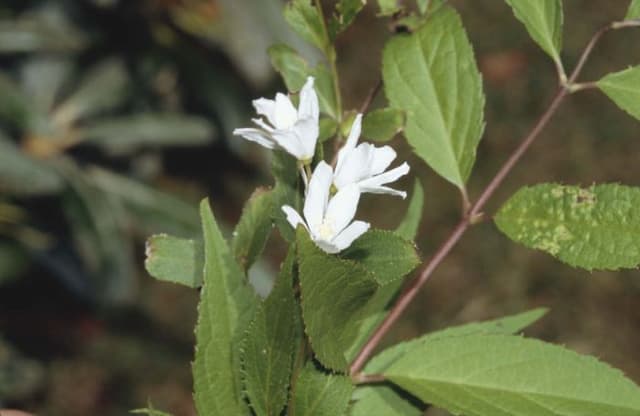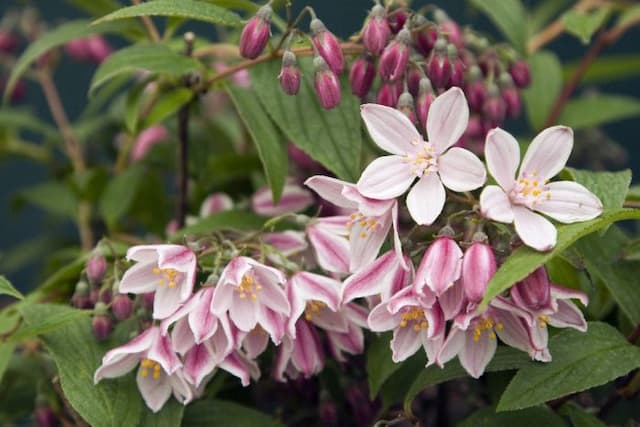Panicle Hydrangea Hydrangea paniculata Confetti = 'Vlasveld 02' (PBR)
![paniculate hydrangea [Confetti]](/_next/image?url=https%3A%2F%2Fplants-admin.emdemapps.com%2Fimages%2Fplants%2F%2Fimages%2F604b5bcfd1579.png&w=3840&q=75)
ABOUT
The Hydrangea paniculata Confetti, commonly referred to as the Confetti Hydrangea, boasts an eye-catching display of blossoms. It is distinguished by its lush flower clusters that take on a conical shape, presenting an array of colors as they mature. These blossoms often initiate a creamy white tone and gradually adopt a palette ranging from soft pink to rich rose and may even exhibit tinges of green. This kaleidoscope of coloration is especially vivid in the late summer and early fall, creating a dynamic visual spectacle. The foliage of the Confetti Hydrangea is equally attractive, with leaves that exude a bright, fresh green hue. These leaves serve as a striking backdrop that accentuates the vibrancy of the flowers. The plant's branches are strong, supporting the substantial flower heads with poise. As the seasons change, the Confetti Hydrangea's appearance transforms, offering a continually evolving aesthetic appeal in gardens and landscaping arrangements.
About this plant
 Names
NamesFamily
Hydrangeaceae
Synonyms
Panicle Hydrangea, Peegee Hydrangea, Tree Hydrangea
Common names
Hydrangea paniculata Confetti = 'Vlasveld 02' (PBR)
 Toxicity
ToxicityTo humans
Hydrangea paniculata, commonly known as panicled hydrangea, contains compounds that can release cyanide when ingested. This can potentially lead to symptoms of poisoning, which may include nausea, vomiting, stomach pain, diarrhea, and in severe cases, respiratory problems, lethargy, coma, or seizures. The level of toxicity typically depends on the amount consumed.
To pets
Panicled hydrangea is also toxic to pets due to the same cyanogenic glycosides present in the plant. If a pet ingests parts of the panicled hydrangea, symptoms can include vomiting, diarrhea, depression, and could potentially lead to more severe signs such as difficulty breathing or lethargy. It's important to keep pets away from this plant and consult a veterinarian immediately if ingestion is suspected.
 Characteristics
CharacteristicsLife cycle
Perennials
Foliage type
Deciduous
Color of leaves
Green
Flower color
Mixed
Height
6-8 feet (1.8-2.4 meters)
Spread
4-6 feet (1.2-1.8 meters)
Plant type
Shrub
Hardiness zones
3
Native area
Asia
Benefits
 General Benefits
General Benefits- Decorative Flowers: Produces large, showy panicles of white flowers that gradually turn pink, adding aesthetic value to gardens.
- Seasonal Interest: Offers visual interest from late summer to autumn, a time when many other plants have finished blooming.
- Hardiness: Tolerant of cold temperatures, making it suitable for a range of climates.
- Low Maintenance: Requires minimal care once established, making it an easy choice for busy gardeners.
- Drought Tolerance: Can survive dry spells, reducing the need for frequent watering.
- Versatility: Suitable for planting in borders, as a specimen plant, or for use in floral arrangements.
- Pollinators Attraction: Attracts bees and butterflies, supporting local biodiversity.
- Longevity: Known to be a long-lived shrub, providing lasting enjoyment in the garden.
 Medical Properties
Medical PropertiesThis plant is not used for medical purposes.
 Air-purifying Qualities
Air-purifying QualitiesThis plant is not specifically known for air purifying qualities.
 Other Uses
Other Uses- Photography Backdrops: The dense, showy flowers of the Hydrangea paniculata Confetti make a stunning backdrop for portrait and macro photography, enhancing the aesthetic appeal of the photo.
- Craft Projects: Dried hydrangea flowers can be used in creating floral crafts like wreaths, arrangements, or pressed flower art, providing a durable and long-lasting decorative item.
- Culinary Garnish: Although not eaten, the blooms can be used as a delicate, colorful garnish for plating desserts and special dishes at high-end restaurants.
- Educational Tools: Gardeners and educators can use this plant to teach about plant care, breeding for particular traits, and the process of Plant Breeders' Rights (PBR).
- Solar Dyeing: The petals of the Hydrangea paniculata Confetti can be used in the process of solar dyeing, where they impart subtle colors to fabrics when left in the sun.
- Bookmarks: Pressed flowers from the Hydrangea can be laminated to create unique and personalized bookmarks.
- Fairy Gardens: The miniature varieties of the hydrangea can provide an enchanting addition to fairy gardens, giving them a whimsical, magical feel.
- Color Change Demonstrations: The ability of hydrangea flowers to change color depending on the soil pH can be used as a demonstration in science classes to teach about soil chemistry.
- Themed Events: The blooms of the Hydrangea paniculata Confetti can be used for decorating venues for events like weddings or baby showers, matching the color theme of the event.
- Fragrance Extraction: Although not a traditional use, the subtle fragrance of the flowers could potentially be extracted and used in making perfumes or scented candles.
Interesting Facts
 Feng Shui
Feng ShuiThe Panicled Hydrangea is not used in Feng Shui practice.
 Zodiac Sign Compitability
Zodiac Sign CompitabilityThe Panicled Hydrangea is not used in astrology practice.
 Plant Symbolism
Plant Symbolism- Heartfelt Emotions: Hydrangeas are often associated with the expression of genuine, heartfelt emotions due to the intensity and abundance of their flower heads.
- Gratitude: In some cultures, giving hydrangeas can symbolize thankfulness and gratefulness, often used to express appreciation for another's understanding.
- Apology: Hydrangeas can be given as a way to apologize, as they are sometimes connected with penitence and the desire to make amends.
- Abundance and Prosperity: Due to the lush and voluminous nature of their flower clusters, hydrangeas can symbolize abundance and prosperity in one's life.
- Frigidity and Heartlessness: Conversely, in some traditions, hydrangeas can have a negative connotation, representing disinterest or a lack of empathy.
- Vanity: The showy characteristic of hydrangeas is occasionally associated with vanity or boasting.
- Fourth Wedding Anniversary: Hydrangeas are traditionally associated with the fourth wedding anniversary, symbolizing appreciation and enduring commitment.
 Water
WaterThe Panicled Hydrangea should be watered deeply once a week, providing about 1 inch of water each time to encourage deep root growth. During hot or dry periods, increase watering to twice per week, ensuring the soil stays moist but not waterlogged. If using a hose or watering can, aim the water at the base of the plant to keep the leaves dry and prevent fungal diseases. In a week, for smaller shrubs, you might use around 1.5 to 2 gallons, while larger specimens may require 3 to 4 gallons, depending on soil drainage and weather conditions.
 Light
LightPanicled Hydrangea thrives best in full sun to partial shade conditions. They prefer morning sunlight with some afternoon shade, especially in hotter regions, to protect them from intense midday heat. The ideal spot for this plant is an area that receives at least 4 hours of direct sunlight but is shielded from the harsh afternoon rays.
 Temperature
TemperaturePanicled Hydrangea can tolerate a range of temperatures and is hardy in USDA zones 3 through 8, withstanding winter temperatures as low as -40 degrees Fahrenheit. Ideally, they prefer temperatures between 65 and 75 degrees Fahrenheit. They can survive summer temperatures up to 95 degrees Fahrenheit, but it's crucial to provide adequate moisture during these warmer periods.
 Pruning
PruningPanicled Hydrangea should be pruned in late winter or early spring before new growth starts, as they bloom on new wood. Pruning helps to shape the plant, encourage new growth, and enhance blooming. It’s recommended to cut back about one-third of the total height to maintain a robust framework. The best time for pruning is when the plant is still dormant, typically after the last hard frost.
 Cleaning
CleaningAs needed
 Soil
SoilPanicled Hydrangea thrives in rich, well-drained soil with high organic matter. The ideal pH for this plant is slightly acidic to neutral, ranging from 5.5 to 7. A good soil mix for Panicled Hydrangea would be equal parts garden soil, compost, and peat moss or pine bark for acidity and drainage.
 Repotting
RepottingPanicled Hydrangea should be repotted every 2 to 3 years or when it becomes root-bound. The best time for repotting is during the dormant period in late winter or early spring before new growth begins.
 Humidity & Misting
Humidity & MistingPanicled Hydrangea prefers average to high humidity levels. Ensuring a relative humidity of around 40-60% is ideal for this plant, which can be achieved in most indoor environments without additional efforts.
 Suitable locations
Suitable locationsIndoor
Ensure bright, indirect light and keep the soil moist.
Outdoor
Plant in partial shade, water regularly, and mulch.
Hardiness zone
3-8 USDA
 Life cycle
Life cycleThe life cycle of Hydrangea paniculata Confetti, commonly known as Panicled Hydrangea, begins with seed germination, where proper soil, moisture, and light conditions allow the seed to sprout roots and shoots. This is followed by the vegetative growth stage, where the plant develops a strong root system and foliage, requiring adequate water, sunlight, and nutrients. During the flowering stage, the plant produces large, showy flower heads starting in early summer through fall, attracting pollinators. After pollination, the flowers may develop into seed heads if conditions are favorable, leading to seed dispersal, which can result in new plants if they find suitable growing conditions. The plant then enters a period of dormancy in the winter, where growth slows down or stops, and the plant conserves energy. As spring returns, the cycle continues with new vegetative growth, completing the full life cycle of Panicled Hydrangea.
 Propogation
PropogationPropogation time
Spring-early summer
The most popular method of propagation for the Hydrangea paniculata Confetti, commonly known as Confetti Hydrangea, is through softwood cuttings. This is typically done in late spring to early summer when the plant's new growth is still tender and pliable but has not yet fully matured or turned woody. Gardeners take a cutting of about 4 to 6 inches (approximately 10 to 15 centimeters) long, making sure to include several pairs of leaves. The lower leaves are then removed, and the cut end is dipped in a rooting hormone to encourage root development. The cutting is then placed in a well-draining soil mix and kept moist until roots have established, which usually takes a few weeks. During this time, it's important to maintain high humidity around the cutting, often by covering it with a plastic bag or placing it in a propagation chamber.







![Hydrangea [Strong Annabelle]](/_next/image?url=https%3A%2F%2Fplants-admin.emdemapps.com%2Fimages%2Fplants%2F%2Fimages%2F604b54db37d34.png&w=640&q=75)

